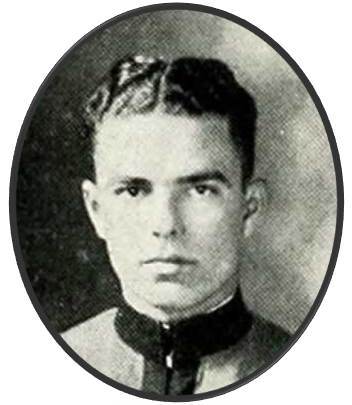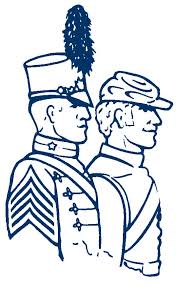Joseph Barre Traywick, Class of 1931
Born on August 31, 1910, to Mrs. Janie Crute Traywick and Dr. A.P. Traywick, Joseph was a native of Cameron, South Carolina. He attended The Citadel and was graduated from the Medical College of South Carolina in Charleston. While at The Citadel, he majored in Chemistry and was a Cadet Private in Cadet Companies F and D his freshman and junior years respectively.
 Cadet Private Joseph Barre Traywick
Cadet Private Joseph Barre Traywick
Class of 1931
In the summer of 1930, Cadet Traywick spent six weeks studying at the Chemical Warfare Training Camp at Edgewood Arsenal, Maryland, and upon completion was commissioned a second lieutenant, officer reserve corps, chemical warfare service.
He served his medical internship at Roper hospital in Charleston. Dr. Traywick was resident physician for the Santee-Cooper project at Holly Hill for two years, after which he went to the University of Virginia medical school, where he was taking a course in pediatrics and children’s diseases when he volunteered for military service.
Captain Traywick, U.S. Army Medical Corps, became the Commanding Officer of the Medical Attachment, 1340th Engineer Combat Battalion. He served overseas two years and was a veteran of the invasion of North Africa, Sicily, Italy, and Normandy.

At the beginning of November, the 1340th Combat Engineer Battalion continued its close support of the 110th Infantry Regiment by opening and maintaining routes of communication and supply as the 28th Division opened its attack on the Vossenack-Schmidt area of the Hurtgen Forest.
On 6 November, the battalion was committed as infantry in the vicinity of Vossenack. The previous night the enemy had counterattacked in this sector and had forced the withdrawal of infantry and engineers from the village of Vossenack and along the road between Vossenack and Kommerscheidt. The 1340th Engineer Combat Battalion, along with elements of the 20th Engineer Combat Battalion, was assigned the mission of defending and holding open to traffic the Kall Trail and the bridge over the Kall River southeast of Vossenack.
Capt. Traywick was killed in action on November 8, 1944 while providing medical attention to the wounded in the field in the fighting around Vossenack, Germany. He was 34 years of age. He was buried in the First Army’s military cemetery at Henri-Chapelle-Eupen, Plot EE, Row 1, Grave 9.
For his gallantry under enemy fire, Capt. Traywick was posthumously awarded the Silver Star Medal. The citation accompanying the award read in part:
“For gallantry in action against the enemy in the period from November 6 to November 8, 1944…
When his unit was assigned the mission of acting as infantry in the vicinity of [Vossenack, Germany], November 6, 1944, Captain Traywick, battalion surgeon, [1340th] engineer combat battalion, voluntarily accompanied the forward elements of the battalion into heavily shelled forward positions. Finding that the routine procedure of establishing an aid station in a sheltered spot and having the wounded brought to him would delay the collection and treatment of casualties for some time, Captain Traywick elected to roam the fire-swept battlefield to treat men at the locations where they were wounded.
In the pursuit of his work, without sleep or rest, night and day, in cold, wet weather, Captain Traywick treated some sixty soldiers, thus greatly increasing their chances of living as a result of almost immediate attention. About 0300 hours on the morning of November 8, 1944, Captain Traywick was hit by enemy artillery fire. Despite painful wounds, he continued to treat others. About 1130 hours on the same day, he was killed by enemy artillery fire while giving aid to a wounded officer to whom he had gone. The heroic and gallant work of Captain Traywick throughout this period reflects great credit upon himself; it is in keeping with the highest traditions of the United States Army.”
After the war, his body was repatriated. Funeral services for Capt. Traywick were conducted on Friday, December 19, 1947 at Arlington National Cemetery at Fort Meyer, Virginia. He rests in eternal peace in Section 12, Site 2544.
Capt. Traywick was survived by his parents; his widow, Pat McLean Traywick, formerly of Laurinburg, N.C.; a small son, Paul Traywick; two sisters and a brother, Major Heber Traywick, who served in Burma.
/RL
Memorial photo courtesy of The Citadel Archives and Museum, Charleston, South Carolina.
Sources:
1928 Sphinx, Annual of the South Carolina Corps of Cadets, Charleston, S.C.
1930 Sphinx, Annual of the South Carolina Corps of Cadets, Charleston, S.C.
Three Battles: Arnaville, Altuzzo, & Schmidt, U.S. Army in World War II, C.B. MacDonald & S.T. Mathews, Department of the Army, Washington, D.C., 1952.
The Gaffney Ledger, Gaffney, S.C., Thursday, July 31, 1930.
The State, Columbia, S.C., November 23, 1944, p.9.
The Robesonian, Lumberton, N.C., Friday, November 24, 1944, p.1.
The State, Columbia, S.C., Saturday, December 21, 1947, p.11-E.
National Cemetery Interment Control Record, National Archives (NARA).
After Action Report, November 1944, HQ 1340th Engineer Combat Battalion.
http://www.fatherswar.com/8thinfdiv/WW2/WW2index.html
Ancestry.com
Findagrave.com



Joseph Barre Traywick……….What a great man and real hero in every sense of the word. A medical man of the highest caliber who put himself in death’s pathway for the good of his men. There is no finer. Strange coincidence that I lost my brother Julian W. Farrior the very next day in the same area in the same way………..that is, by a German artillery shell………….and Julian was no less brave……Stanley M. Farrior